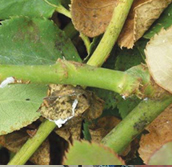 Today, more than ever, the agricultural sector is feeling the pressure of emerging pests and diseases. Intensive international movement of plant material, fruit, vegetables and ornamental plants contribute to this. Moreover, many of the previous known pathogens and insect pests have also become more resilient and resistant to chemical pesticides. A shrinking pool of available chemicals, coupled with few new entrants, means that growers are heavily burdened.
Today, more than ever, the agricultural sector is feeling the pressure of emerging pests and diseases. Intensive international movement of plant material, fruit, vegetables and ornamental plants contribute to this. Moreover, many of the previous known pathogens and insect pests have also become more resilient and resistant to chemical pesticides. A shrinking pool of available chemicals, coupled with few new entrants, means that growers are heavily burdened.
Where we are as Kenyan growers
Kenyan cut-flower growers have in the recent years adopted biological control and integrated pest management (IPM). In spite of this achievement, growers still have to contend with less success in using the same approach to control emerging pests. To date, IPM has focused on insect pests and not on common diseases such as powdery mildew, downy mildew and botrytis. To add insult to injury, more and more bacterial and viral infections are occurring in crops and as a response to this, growers are frequently resorting to disinfectants.
The disadvantage of disinfectants and chemical pesticides is that in many cases they are only effective for a short period. Often, only part of the population of the pathogen is killed, and/or the pathogen develops resistance. Since the very practice of monocropping sometimes necessities the intensive use of chemical pesticides, is there a better way of working around this situation while still producing healthy crops as a grower?
 Employing nature as the first line of defence
Employing nature as the first line of defence
If you look in the wild, you will see that most plants grow splendidly and look healthier than managed agricultural fields. In one study, researchers established that most wild plants have viruses, yet they don’t have any of the symptoms that we usually see in crop plants with viruses. Professor Marilyn Roossinck who examined more than 7,000 individual plants for viruses, noted one interesting phenomena in Costa Rica. One plant virus that was found frequently in the forest was also found in nearby melon crops. In the melons it was causing severe disease, while in the wild plants there were no symptoms. The most pertinent question remains, how do wild plants avoid disease? and perhaps most importantly, is there is a way this can be used in agriculture?
This mystery has just began to be revealed to us. One of the most consistent pointers is the fact that in natural environments, the ecosystem is abundant with a wide array of microbes which include viruses, fungi and bacteria. On the other hand, in conventional cropping systems we are consistently trying to eliminate these microbes. There is a great diversity of micro-organisms to be found around the roots of a plant, and each has a specific role within the growth medium. Bacteria, fungi and protozoa (single-cell organisms) live around and interact with the plant’s roots. This is called the soil food web. A well-balanced soil food web makes an important contribution to the health of plants. Good micro-organisms provide the plant with the necessary nutrients and disease-suppressant elements.
In addition to processing organic matter, active fungi and bacteria can produce substances that suppress pathogens, but also plant hormonelike substances that influence plant growth positively. All kinds of nematodes can be found in the soil, fungal feeders, bacterial feeders and other nematode-eaters. Only a few harmful species eat plant roots. Nematodes play an important role in the regulation of the populations of other organisms, and in the nutritive balance in the root zone.
Finally, other important organisms are the protozoa which eat bacteria. Their excreta is also rich in nutrients which are very easily absorbed by the plant. Based on this understanding, it is easy to see why the soil food web should be maintained in balance. Plant roots communicate (signal) their environment by excreting exudates that feed the microorganisms in the root. In return, the microorganisms release nutrients, growth compounds and disease supressing compounds.
 From control to adaptation
From control to adaptation
The most sure-fire way to create and sustain the soil food web in our commercial crops is to employ a different approach that focuses on the whole system rather than solutions to individual problems as far as pests and diseases control are concerned. That means changing our mind set from the need to control individual pests and diseases in crops, to adapting our crops to thrive better. This is something we can influence with the right products -not used in isolation, but combined to form a complete system.
The `whole system approach’ should include:
- Addition of beneficial organisms with proven value.
- Increasing biodiversity in the plant zone.
- Avoiding obstacles that hinder the development of a balanced soil food web especially use of harmful chemical pesticides, disinfectants and unfavourable abiotic conditions such as excess moisture and temperatures.
- Feeding of the beneficial organisms in the root zone with the right biostimulants to support plant growth.
- Use of plant-compatible amino acids and other bio-stimulants to encourage and support plant metabolism and finally, analysis of the soil food web in order to understand the status of various microorganisms in terms of their identity and activity.
Healthy plants -the security of every grower
The possibility of growing profitable crops using less fertilizer and pesticides can be a reality for every grower who is willing to start with this resilient cultivation. A healthy plant with good resistance levels is less susceptible to diseases such as Pythium, Fusarium, various mildews and Botrytis. Ultimately, this guarantees operational security, greater yields of high quality, sustainable cultivation, and food safety.
